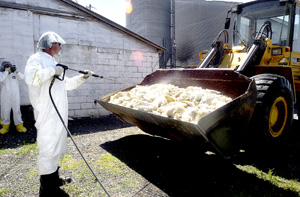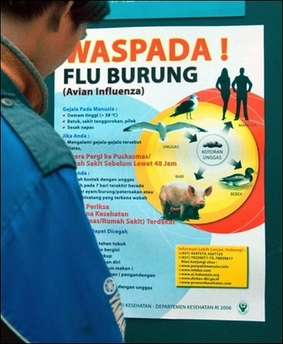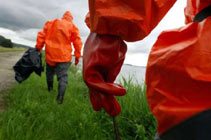Entries by Scott McPherson (423)
A Sulfur Cockatoo, a crocodile, a wild boar, and a kangaroo mouse walk into a bar....
One bright spot in a sea of failed national attempts at H5N1 prevention has been the Republic of the Philippines. Besides the 2005 Meningococcal septicemia/bird flu scare and a 2005 small low-path H5N1 outbreak, the island nation has worked itself to be (so far) bird flu-free.
So I have probably just jinxed them! Anyway, their vigilance has paid off again, as the following news story attests:
 Government agents in Davao City arrested Sunday an Indonesian and two Filipinos Sunday for smuggling into the country exotic birds from Indonesia, a bird flu "hotspot" in Southeast Asia.
Government agents in Davao City arrested Sunday an Indonesian and two Filipinos Sunday for smuggling into the country exotic birds from Indonesia, a bird flu "hotspot" in Southeast Asia.Sun.Star Davao reported Tuesday that the confiscated animals were exterminated Monday to prevent the possible spread of avian influenza.
The National Bureau of Investigation (NBI), whose agents made the arrest and seizure, said the extermination was done in its regional office in Davao City.
There are already 101 confirmed cases of bird flu in humans in Indonesia, 80 of which have been fatal.
The Philippines, meanwhile, has so far maintained its bird flu-free status in the region.
Confiscated from the suspects were a Bird of Paradise, three Rainbow Lories, a Black Palm, a Sulfur Cockatoo, two Gaski Lories, a Black Cut Lory, a Black Lory, a crocodile, a wild boar, and a kangaroo mouse.
The NBI identified the suspected smugglers as Indonesian national Randy Mandumi Makaginggi; Mike Antucilla, 36, a resident of Davao City; and Renante Toledo a.k.a. Nante, a resident of Lasang, Davao City. They were arrested at noon Sunday.
Antucilla, the primary suspect, travels to Indonesia at least once a month to get stocks and was using the Indonesian national as interpreter and as his accomplice.
Antucilla and Toledo are now detained at the NBI and face charges for violating the Wildlife Conservation and Protection Act. Makaginggi was brought to the Bureau of Immigration to face appropriate charges.
"This is a month-long surveillance and product din of intelligence reports from the agents of the bureau," said Exzel Hernandez of the NBI.
Hernandez said the suspects were said to be smuggling various contraband like firearms, ammunition, shabu while using the birds as cover for the smuggled items.
He said the suspects would also smuggle in snakes on a "per order" basis.
The NBI said it is verifying reports that the same gang was also involved in human smuggling.
Hernandez said the birds and other creatures were turned over to Department of Agriculture (DA) instead of the Department of Environment and Natural Resources (DENR) Protected Areas and Wildlife Bureau (PAWB).
Under the setup of the National Avian Flu Task Force, the DA's Bureau of Animal Industry is the lead agency for bird flu for as long as there is still no human infection reported.
Only two weeks ago, another case of bird flu infection on a three-year-old girl was confirmed in Indonesia. She has since recovered.
Outbreaks of the virus both in animals and humans continue to be confirmed in Indonesia, the latest of which was just last month. - GMANews.TV
Virginia's sick turkeys, blowflies, and an Indonesian mystery
 Well, the discovery that low-path H5N1 was present in a flock of some 54,000 turkeys in Virginia didn't seem to phase anyone. I should explain that low-path H5N1 is found in wild birds across the United States all the time. In fact, Delaware seems to be routinely testing and finding low-path H5N1 in wild birds (and maybe the WHO and OIE and FAO and the whole "alphabet soup gang" should simply outsource wild bird testing to Delaware?).
Well, the discovery that low-path H5N1 was present in a flock of some 54,000 turkeys in Virginia didn't seem to phase anyone. I should explain that low-path H5N1 is found in wild birds across the United States all the time. In fact, Delaware seems to be routinely testing and finding low-path H5N1 in wild birds (and maybe the WHO and OIE and FAO and the whole "alphabet soup gang" should simply outsource wild bird testing to Delaware?).
But finding LP H5N1 in wild birds and finding it in a Virginia turkey farm are two different things. And, as I have said over and over again -- if left untreated, low path bird flu goes in, and high path bird flu comes out. This reality has presented itself countless times in poultry farms across the nation and, indeed, across the world.
Recall that up until 2003, the world leader in avian influenza outbreaks among domestic poultry was -- drum roll, please -- the United States of America. As written in Dr. Michael Greger's excellent tome "Bird Flu: A Virus of Our Own Hatching," Greger presents a compelling argument that it might be the Delmarva Peninsula within the Delaware, Virginia and Maryland triangle, and not Guangdong, China or Jakarta, Indonesia, where a pandemic launches.
So you gotta love the comments from the United States Department of Agriculture's Dr. John Clifford, from USDA's National Veterinary Services Laboratories (from Reuters).
The turkeys had antibodies to a low pathogenic form of the H5N1 avian influenza virus, Clifford said. This strain of H5N1 does not usually make birds ill, although it could potentially change into a more dangerous form if allowed to spread.
"Every indication is that the virus detected is consistent with the North American strain of low pathogenic H5N1, which is not a human health concern," Clifford said in a statement.
"The turkeys showed no signs of illness, and there was no mortality. Thus far, there is no evidence the virus is actually present in the samples collected. The testing detected only antibodies, which indicate possible past exposure to the virus."
Allow me to translate this obviously encoded message. What he means is not "possible,' but "likely" exposure to the H5N1 virus, even if low-path. Turkeys do not get hatched with H5N1 in their veins. This means that a flock of 54,000 turkeys -- destined for the dinner tables of America and elsewhere -- had exposure to H5N1 enough to have produced antibodies. This means that very, very recently (remember, turkeys do not live very long, unless pardoned by the President at Thanksgiving), there was H5N1 on that farm. And the turkeys were exposed to it. According to statistics provided by animalaid.org, turkeys are slaughtered at 12 to 26 weeks, even though they may live to ten years of age. However, according to Website maguirefarm.com, turkeys bred for food usually cannot support their weight after a year. So, this means that sometime in the past 12 weeks to a year, low-path H5N1 was present in significant volume on the farm in question. And it got past the breeders and the State and Federal authorities. So it is possible that a low-pathogenic H5N1 could have entered this unnamed Virginia farm, circulated among the 54,000 birds, and its progeny could have been high-path H5N1. Now that is a sobering thought, that surveillance in the US missed this important development.
West Virginia, hit with its own heavily publicized low-path H5N2 outbreak just weeks ago, cancelled a poultry festival and is taking other steps to ensure the virus does not cross its border with Virginia. From an AP story in the Charleston Daily News:
Although the virus has not been found in West Virginia, the state Poultry Association decided Monday to cancel the five-day festival because area poultry farmers attending the festival might unwittingly transport the virus to other farmers, said Emily Funk, the association's executive secretary.
"When we have an avian outbreak like this we try not to get together," she said. "Try not to go to the grocery store. We try not to associate with each other."
"The festival is held in Moorefield, which will go ahead with its carnival and golf tournament for nonfarming residents. What will be missing are the beauty pageant and various education dinners and activities sponsored by the association, she said.
It's at least the second time since the 1980s that the festival has been canceled, she said.
State Agriculture Commissioner Gus Douglass said the low pathogenicity avian influenza found in a turkey flock in Mt. Jackson, Va., about 71 miles southeast of Moorefield, is not the same as the bird flu found in Southeast Asia, Europe and other countries.
Folks, the farmers do not associate with each other because they can shed virus from their clothing and shoes/boots, to be picked up by their neighbors -- and because they can also hypothetically be asymptomatic carriers of low-path H5N1.
 In another story, North Carolina State University reports that H5N1 can remain active in the stomachs of common houseflies for up to three hours. This study cited a 1985 study of housefly infestations with avian influenza stemming from 1983's huge H5N2 outbreak in Lancaster County, Pennsylvania. That study showed that more than a third of the houseflies trapped during the H5N2 outbreak had bird flu virus in their guts. Following a Kyoto, Japan outbreak of "bad" H5N1 in 2004, more evidence was collected to support the flies-as-vectors theory.
In another story, North Carolina State University reports that H5N1 can remain active in the stomachs of common houseflies for up to three hours. This study cited a 1985 study of housefly infestations with avian influenza stemming from 1983's huge H5N2 outbreak in Lancaster County, Pennsylvania. That study showed that more than a third of the houseflies trapped during the H5N2 outbreak had bird flu virus in their guts. Following a Kyoto, Japan outbreak of "bad" H5N1 in 2004, more evidence was collected to support the flies-as-vectors theory.
Nonetheless, nothing of consequence has been done to reduce or eliminate houseflies as a serious vector of avian influenza within the poultry industry.
Let me say that I know the masked R&B artist Blowfly personally and he is not responsible.
 Now, a quick look at the story coming out of Indonesia that a six year old boy who died of H5N1 was not exposed to poultry. That the story was broken by the Indonesian Agricultural Ministry is amazing. Here is an official organ of the Indonesian government admitting that this young lad had no exposure to poultry or wild birds -- but he did, apparently, go to the zoo recently. From a recent Reuters story:
Now, a quick look at the story coming out of Indonesia that a six year old boy who died of H5N1 was not exposed to poultry. That the story was broken by the Indonesian Agricultural Ministry is amazing. Here is an official organ of the Indonesian government admitting that this young lad had no exposure to poultry or wild birds -- but he did, apparently, go to the zoo recently. From a recent Reuters story:
It is always a concern when the cause of a human infection cannot be traced as it makes infection control more difficult.
Runizar Ruesin, the head of the health ministry's bird flu centre, said that at least 20 of chickens near the boy's school had died suddenly.
"But we are still investigating whether he had a contact with sick or dead chickens in the neighbourhood," the official said.
A spokeswoman at the Jakarta hospital where the boy was treated said that along with some chickens dying near the boy's school there were also water fowl in the school area.
"There are a lot of water fowl roaming near the boy's school although they probably didn't get into the school," said Tuty Hendrarwardati, a spokeswoman for the Sulianti Saroso hospital.
The boy, who had been suffering from fever before visiting relatives in the city of Bandung on June 25, had also been to the zoo, she said.
Even if the boy was infected by a neighborhood chicken, look at the ease with which the infection took place. The Elephant in the Room is the question of the samples the Indonesian government finally gave up to the WHO, following their little spat over vaccine rights and first dibs. What precious time was lost in isolating changes in the virus? And what are those changes? They are apparently enough to cause the Indonesian government to begin rush production of a prepandemic vaccine while ignoring WHO entreaties to stockpile rather than inject. The Indonesian government has decided to "stockpile vaccine in people, not buildings," which was the rallying cry of the Ford Administration's Swine Flu decision in 1976. And the Indonesian government has one heckuva lot more evidence to support its decision than Ford did in 76. Dr. Harvey Fineberg, onetime head of Harvard's public health school and now president of the Institute of Medicine, wrote of this decision in his book Decision-Making on a Slippery Disease. Dr. Fineberg and I correspond frequently on pandemic public policy issues, and his book should be required reading for anyone interested in the public policy angle of a looming pandemic. The Ford Administration's decision to stockpile in people was assailed for not having enough surveillance or actionable intelligence on the virus to warrant exposure to the vaccine's side effects. And even though hundreds of people wound up testing H1N1-positive, only one soldier died.
In contrast, Indonesia has the highest H5N1 death rate in the world, with the virus so endemic that a six-year-old boy can die from it by apparently just walking by sick chickens, seeing waterfowl or attending a local zoo. Or from some other vector, be it blowfly, cat, or bird. Surveillance shows that the world may have dodged the Indonesian pandemic bullet twice in the past fourteen months alone by quick action from the Indonesian government, the United States and the WHO. Maybe we should pay much closer attention to what is really going on down there.
Flash! iPods turn people into human lightning rods
An incredible AP story in today's Yahoo News, submitted by alert reader Mark Schlaudraff, serves as a cautionary tale to never wear or use portable electronic devices when it is raining or if you hear thunder.
http://asia.news.yahoo.com/070711/ap/d8qakrd01.html
Thursday July 12, 5:36 AM
Lightning Strikes Reported by IPod Users
 Listen to an iPod during a storm and you may get more than electrifying tunes. A Canadian jogger suffered wishbone-shaped chest and neck burns, ruptured eardrums and a broken jaw when lightning traveled through his music player's wires.
Listen to an iPod during a storm and you may get more than electrifying tunes. A Canadian jogger suffered wishbone-shaped chest and neck burns, ruptured eardrums and a broken jaw when lightning traveled through his music player's wires.
Last summer, a Colorado teen ended up with similar injuries when lightning struck nearby as he was listening to his iPod while mowing the lawn.
Emergency physicians report treating other patients with burns from freak accidents while using personal electronic devices such as beepers, Walkman players and laptop computers outdoors during storms.
Michael Utley, a former stockbroker from West Yarmouth, Mass., who survived being struck by lightning while golfing, has tracked 13 cases since 2004 of people hit while talking on cell phones. They are described on his Web site,
Contrary to some urban legends and media reports, electronic devices don't attract lightning the way a tall tree or a lightning rod does.
"It's going to hit where it's going to hit, but once it contacts metal, the metal conducts the electricity," said Dr. Mary Ann Cooper of the American College of Emergency Physicians and an ER doctor at University of Illinois Medical Center at Chicago.
When lightning jumps from a nearby object to a person, it often flashes over the skin. But metal in electronic devices _ or metal jewelry or coins in a pocket _ can cause contact burns and exacerbate the damage.
A spokeswoman for Apple Inc., the maker of iPods, declined to comment. Packaging for iPods and some other music players do include warnings against using them in the rain.
Lightning strikes can occur even if a storm is many miles away, so lightning safety experts have been pushing the slogan "When thunder roars, go indoors," said Cooper.
Jason Bunch, 18, says it wasn't even raining last July, but there was a storm off in the distance. Lightning struck a nearby tree, shot off and hit him.
Bunch, who was listening to Metallica while mowing the grass at his home in Castle Rock, Colo., still has mild hearing damage in both ears, despite two reconstructive surgeries to repair ruptured eardrums. He had burns from the earphone wires on the sides of his face, a nasty burn on his hip where the iPod had been in a pocket and "a bad line up the side of my body," even though the iPod cord was outside his shirt.
"It was a real miracle" he survived, said his mother, Kelly Risheill.
The Canadian jogger suffered worse injuries, according to a report in Thursday's New England Journal of Medicine.
The man, a 39-year-old dentist from the Vancouver area, was listening to an iPod while jogging in a thunderstorm when, according to witnesses, lightning hit a tree a couple of feet away and jumped to his body. The strike threw the man about eight feet and caused second-degree burns on his chest and left leg.
The electric current left red burn lines running from where the iPod had been strapped to his chest up the sides of his neck. It ruptured both ear drums, dislocated tiny ear bones that transmit sound waves, and broke the man's jaw in four places, said Dr. Eric Heffernan, an imaging specialist at Vancouver General Hospital.
The injury happened two summers ago and despite treatment, the man still has less than 50 percent of normal hearing on each side, must wear hearing aids and can't hear high-pitched sounds.
"He's a part-time musician, so that's kind of messed up his hobby as well," Heffernan said.
Like the Colorado teen, the Canadian patient, who declined to be interviewed or identified, has no memory of the lightning strike.
In another case a few years ago, electric current from a lightning strike ran through a man's pager, burning both him and his girlfriend who was leaning against him, said Dr. Vince Mosesso, an emergency doctor at University of Pittsburgh Medical Center.
Eardrum ruptures are considered the most common ear injury in lightning-strike victims, occurring in 5 percent to 50 percent of patients, according to various estimates _ whether or not an electronic device is involved. A broken jaw is rare, doctors say.
NOTE: The photo is not of an iPod after a lightning strike. It is an iPod after a welding torch got it. Pulled it off YouTube. - Scott
Is Kelbra Lake the new Qinghai?
 Reports coming out of Germany continue to parlay bad news after bad news. It appears that a small lake in central Germany may be the most significant body of water to enter the lexicon of H5N1 trackers since China's Qinghai Lake in May, 2005.
Reports coming out of Germany continue to parlay bad news after bad news. It appears that a small lake in central Germany may be the most significant body of water to enter the lexicon of H5N1 trackers since China's Qinghai Lake in May, 2005.
That Chinese body of water spawned the most significant spread of high-path H5N1, now known as Clade 2.2, or the Qinghai strain of H5N1. This subtype has spread across Asia, Europe and now Africa. It reaches from the Ivory Coast to the Middle East, to France and Britain, to Moscow and Siberia.
Now, Qinghai H5N1 has gained a solid footing in a small (about 3 square miles) lake called Kelbra in central Germany. Formed as the result of a dam, this arfificial lake is close to a popular tourist campground. And it appears to be teeming with H5N1. More than 300 dead birds have been fished from the water and tested in the past few weeks, and the overwhelming majority are H5N1-positive.
If this is not bad enough news, now small farms in adjacent nation-state Czech Republic are experiencing problems with H5N1 in their flocks, and thousands of birds were and are being culled across Europe. France has found H5N1 in swans, and France and Germany have raised their threat levels accordingly. Egypt, of all nations, has now blocked the import of French and German poultry. And with each passing day, the body count of dead wild birds increases across the continent.
H5N1's renewed spread across Western Europe reveals it once again to be a robust, hearty and evolving pathogen. Its ability to "go underground" and smoulder, then reappear at the most unlikely times, continues to confound the world's leading experts on influenza.
Why anyone on this planet would think that H5N1 is a non-threat does not understand influenza. And that is because the people on this planet who do understand influenza have been warning us for years that this disease is incredibly crafty and resilient.
This also underscores a growing and neglected problem; namely, the lack of a reliable test on live wild birds for H5N1. The story is the same across the globe: Live wild birds test negative for H5N1, wild birds die, wild birds test positive for H5N1. Is this because we do not have sufficient numbers of birds tested? Is this because we do not have a reliable test for the presence of H5N1 in live wild birds? Are we using the wrong test on the wrong birds? Are we swabbing the "wrong end" of the birds? Are we not swabbing throats and only focusing on the cloacal (rear end) area?
Anyone who has seen the lengths researchers have to go to just to capture wild birds for testing understands the extreme difficulty in the process. Nets, snares, traps, etc. are a pain in the cloaca. No wonder the numbers tested are so low!
But test we must, because we must know if Kelbra has become the Qinghai of Europe: The new endemic source of H5N1 for an entire continent.
Feds "get jiggy*" with pandemic planning oversight
* " get jiggy with it" = to become excited about or involved in something (courtesy of Microsoft Encarta and Will Smith)
 Or, The Rise of the Auditors.
Or, The Rise of the Auditors.
Two recent announcements underscore the ratcheting-up of U.S. Government interest in private sector and State government pandemic planning efforts. First, the Treasury Department is holding its largest test of the financial sector's resiliency in the face of a protracted influenza pandemic. From the ABA release:
"The industry-wide pandemic exercise will take place from September 24 through October 12, 2007. Sponsored by the Treasury Department, the voluntary exercise will bring together the public and private sector and will focus on the continuity of financial services in the event of a pandemic. Treasury is encouraging financial institutions of all sizes from across the country, including banks, credit unions, securities firms, and insurance companies, to participate.
"Information about the FBIIC/FSSCC Pandemic Flu Exercise of 2007 is now available on a dedicated website: www.fspanfluexercise.com . This site is the main portal for exercise information, registration to participate, and to “play” in the exercise. At this time, initial documentation is available on the site and additional documents will be posted periodically. Registration will begin in mid-July and be open through Labor Day. The Registration and Login buttons on the website will be activated at that time. An announcement will be made when registration opens. Please refer to this site periodically for updated information.
"As we obtain additional information we will pass it along, and will certainly alert you when registration is finally open. In the meantime have a great Fourth of July. "
Good news for the financial sector, and those who use ATMs. The banking interests are taking this seriously.
As are the auditors! When I ran Y2K efforts in Florida, I had to do something that would strike fear and loathing into the hearts of county commissioners and school superintendents statewide. I had to use methods so devious and sinister that no one would dare call me out.
I used every auditor in State government. You beast, you label me! You, you, you monster! But I had the entire resources of the Auditor General's office (more than 200 State auditors) and more than eighty policy analysts from the State's Office of Program Policy and Government Analysis (OPPAGA). We trained them and sent them to the four corners of Florida, examining the Y2K efforts of more than 3,000 governmental entities.
So I am buoyed to see that the U.S. Government Accountability Office is moving decisively to examine State government pandemic planning efforts. Specifically, the GAO is traveling to four states: California, Florida, Illinois, New York and Texas. Wait, that's five states. They will meet with emergency management, public health and homeland security representatives to assess their respective states of readiness and review their pandemic plans. The GAO is conducting this audit at the request of Senator Judd Gregg (R-New Hampshire). Senator Gregg serves on the Senate Budget Committee.
Should be interesting. I am part of the Florida team.
